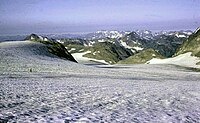
Photo from wikipedia
ABSTRACT Accelerated discharge through marine-terminating outlet glaciers has been a key component of the rapid mass loss from Arctic glaciers since the 1990s. However, glacier retreat and its climatic controls… Click to show full abstract
ABSTRACT Accelerated discharge through marine-terminating outlet glaciers has been a key component of the rapid mass loss from Arctic glaciers since the 1990s. However, glacier retreat and its climatic controls have not been assessed at the pan-Arctic scale. Consequently, the spatial and temporal variability in the magnitude of retreat, and the possible drivers are uncertain. Here we use remotely sensed data acquired over 273 outlet glaciers, located across the entire Atlantic Arctic (i.e. areas potentially influenced by North Atlantic climate and/or ocean conditions, specifically: Greenland, Novaya Zemlya, Franz Josef Land and Svalbard), to demonstrate high-magnitude, accelerating and near-ubiquitous retreat between 1992 and 2010. Overall, mean retreat rates increased by a factor of 3.5 between 1992 and 2000 (−30.5 m a−1) and 2000–10 (−105.8 m a−1), with 97% of the study glaciers retreating during the latter period. The Retreat was greatest in northern, western and south-eastern Greenland and also increased substantially on the Barents Sea coast of Novaya Zemlya. Glacier retreat showed no significant or consistent relationship with summer air temperatures at decadal timescales. The rate of frontal position change showed a significant, but weak, correlation with changes in sea-ice concentrations. We highlight large variations in retreat rates within regions and suggest that fjord topography plays an important role. We conclude that marine-terminating Arctic outlet glaciers show a common response of rapid and accelerating retreat at decadal timescales.
Journal Title: Annals of Glaciology
Year Published: 2017
Link to full text (if available)
Share on Social Media: Sign Up to like & get
recommendations!